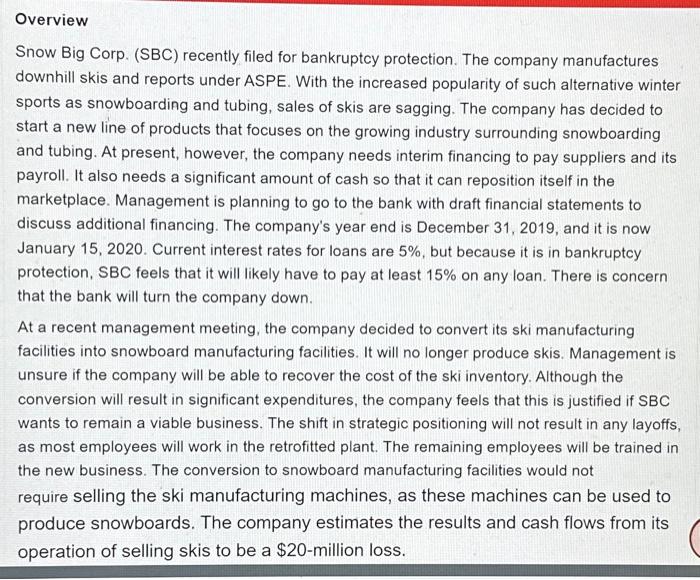Snow Big Corp. (SBC) recently filed for bankruptcy protection. The company manufactures downhill skis and reports under ASPE. With the increased popularity of such alternative winter sports as snowboarding and tubing, sales of skis are sagging. The company has decided to start a new line of products that focuses on the growing industry surrounding snowboarding and tubing. At present, however, the company needs interim financing to pay suppliers and its payroll. It also needs a significant amount of cash so that it can reposition itself in the marketplace. Management is planning to go to the bank with draft financial statements to discuss additional financing. The company's year end is December 31,2019, and it is now January 15,2020 . Current interest rates for loans are 5%, but because it is in bankruptcy protection, SBC feels that it will likely have to pay at least 15% on any loan. There is concern that the bank will turn the company down. At a recent management meeting, the company decided to convert its ski manufacturing facilities into snowboard manufacturing facilities. It will no longer produce skis. Management is unsure if the company will be able to recover the cost of the ski inventory. Although the conversion will result in significant expenditures, the company feels that this is justified if SBC wants to remain a viable business. The shift in strategic positioning will not result in any layoffs, as most employees will work in the retrofitted plant. The remaining employees will be trained in the new business. The conversion to snowboard manufacturing facilities would not require selling the ski manufacturing machines, as these machines can be used to produce snowboards. The company estimates the results and cash flows from its operation of selling skis to be a $20-million loss. On December 15,2019 , the company entered into an agreement with Cashco Ltd. to sell its entire inventory in ski bindings to Cashco. Under the terms of the deal, Cashco paid $10 million cash for the inventory (its regular selling price at the time). The cost to SBC of this inventory was $6 million and so a profit of $4 million was booked pre-tax. In a separate deal, SBC agreed to buy back the inventory in January for $10,125,000. Before filing for bankruptcy protection, the company was able to buy a large shipment of snow tubes wholesale for a bargain price of $7 million from a supplier that was in financial trouble. The value of the inventory is approximately $10 million. The inventory was sitting in the SBC manufacturing facility taking up a lot of space. Because the manufacturing facility was being renovated, SBC reached an agreement with its leading competitor, Alpine Gear Ltd. (AGL). According to the contract, AGL agreed to purchase the snow tubes from SBC for $8 million, and SBC shipped the inventory on December 31 to arrive on January 5 . The inventory was shipped f.o.b. shipping point. SBC normally reimburses its customers if the inventory is damaged in transit. SBC has a tentative verbal agreement that it will repurchase the snow tubes that AGL does not sell by the time the renovations are complete (in approximately six months). The buyback price will include an additional amount that will cover storage and insurance costs. REQUIRED: Adopt the role of Rachel Glover - the company controller-and discuss the financial reporting issues related to the preparation of the financial statements for the year ended December 31 , 2019. (use the case analysis framework covered in the course, refer to the "Discussion Section" for reference if needed)








